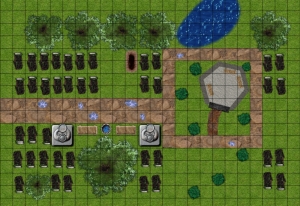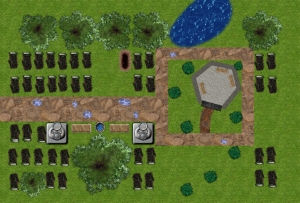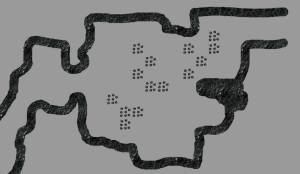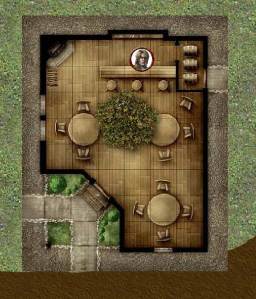As I sit down to write this post Monday morning, I’m exhausted and happy for the past three-plus days I spent over the weekend at Genghis Con 2012. The Denver Gamers Association puts on two conventions each year: Genghis Con over Presidents’ Day weekend, and TactiCon over Labor Day weekend. I think they’re very smart in having each convention begin Thursday night and end Sunday evening, with Monday off for all of us to recover before we have to go back to our day jobs on Tuesday after the holiday.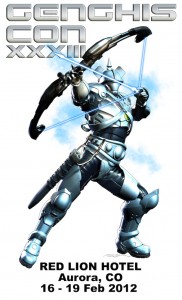
Last TactiCon, I decided to be a Marathon GM and run games in all nine time slots (Thursday evening; Friday morning, afternoon and evening; Saturday morning, afternoon and evening, and finally Sunday morning and afternoon). For Genghis this year, I decided I wanted to run just three sessions (of games I’d written myself) and then play the rest of the time. I signed up for two specific games to play in – a Dresden Files game and a Hero System game based on Dr. Horrible’s Sing Along Blog. I wanted to keep my options open for the rest of the time.
I received an email a few weeks before the convention that the Dr. Horrible game was canceled. Oh well. Then I got an email two weeks ago letting me know that the person who was supposed to have been coordinating the D&D 4th Edition games at the convention (mainly Living Forgotten Realms) had gone incommunicado, and lots of games needed DMs. I was asked to help out.
So, I went from running three slots to running seven. Seven slots, seven different games. Two of them were Ashes of Athas, and I knew next to nothing about Dark Sun. Two were paragon tier LFR games (one of which, thankfully, I had run before and so already had prepared in MapTool). A couple of weeks of frantic prep work followed, including taking last Thursday off work to get ready. And then away we go!
Thursday
I got to the convention at the Red Lion Hotel around 6:00 PM to pick up my badge. The awesome RPG coordinator had arranged for me to get a refund for the sessions I had originally signed up to play in but was now running instead. You rock, Linda!
This was one of the two times in the convention when I was a player rather than a DM. I jumped into an LFR game that could be run for characters of levels 1-10, but the table has to agree on a four-level band. I really wanted to play Factotum, my beloved bard, who was fifth level. Unfortunately, there were a couple of other players who really wanted to play their 9th and 10th level characters. And thus I turned to Rhogar, my first-ever LFR character – a half-elf paladin of Ilmater. I hadn’t played him since Genghis Con 2011.
The adventure itself was set in Elturgard, and I should have known better. Rhogar’s last adventure was the Paladins’ Plague adventure in Elturgard, and I ended up having the least fun ever with that adventure. This adventure was somewhat similar, in that it was a very dark adventure with some no-win plot choices at the end. I left feeling victorious in the adventure, but kind of bummed out at the same time.
Friday
Friday was the day I was originally scheduled to run games, and I brought my projector rig on down to the convention. I was running the Staff of Suha trilogy (The Stolen Staff, Tallinn’s Tower and Descent Into Darkness). This was the second  convention in a row where I’d run all three games, and I was excited to see that I had three players who would be involved in all three games and everyone else would be involved in two of the three. A fun twist in this particular series is that one of the players needed a fifth level character to play, and I offered to let him play Factotum the bard, which he totally ran with.
convention in a row where I’d run all three games, and I was excited to see that I had three players who would be involved in all three games and everyone else would be involved in two of the three. A fun twist in this particular series is that one of the players needed a fifth level character to play, and I offered to let him play Factotum the bard, which he totally ran with.
Things went pretty well in The Stolen Staff. I was happy that this party became the first to find the secret entrance to the orcs’ keep via the garbage pit, and the encounter down there was fun. It did take a long time to get to that point, though, so I ruled on the fly that the secret entrance let the party bypass most of the skill challenge through the stronghold. The fight in the orc temple was also cool, as this party was the first to let the orc shaman live more than a couple of rounds, which made the other orcs much more deadly. The fight against the orc leader in the end was only so-so; I still need to work on making him more interesting.
Tallinn’s Tower went smoothly enough, with the party eventually figuring out how the puzzle on the first floor worked, and then disabling the trap on the second floor very quickly, which made that fight much easier. The third floor got a little bit brutal, but the party whomped on the leader in time to prevent folks from turning to stone. Barely.
Descent Into Darkness went just okay, I’d say. The party solved the rune puzzle quickly, but not so quickly as to be trivial. They were a little bit tempted by the decoy sword but moved on before getting into too much trouble. They also took more of a negotiation approach with the halflings before Factotum decided to attack. That battle was more lethal than I intended it to be with the thieves; I need to tweak those guys. The climax fight against the beholder was a little anti-climactic, as the beholder got held in Bigby’s Icy Grasp and stayed there for three rounds. The party fought well, though, grabbed the Shield and got out of there, leaving the beholder alive (as most parties have done).
There was one player at the table who wasn’t having as much fun as the rest, and I tried and failed to get him more excited about the game. This was a bummer, as I like the guy, but he wasn’t having a great time. Oh well; I can’t blame anyone but myself, since I wrote the modules!
Saturday
Saturday was Ashes of Athas day. I had prepped my two sessions a couple of days before the convention and had thoroughly read one of them, but I had to finish reading the second during the hour-long break between sessions. I got there, though!

The Ashes of Athas modules are definitely more role-play heavy than most LFR modules, and that demands the right sort of players (and a prepared DM, which I just barely was). Fortunately, I had an awesome table. They were really into Dark Sun and spent way more time in-character than I’ve ever experienced before in D&D. I could tell that they really saw the various NPCs as actual characters, not just names and stat blocks. I felt successful when I realized that they truly hated one NPC, grokked another’s focus on the bottom line (her quote about profits being down 18% became a recurring bit), felt sympathy toward another, etc. The combats were only so-so, but I don’t think anyone cared – they loved the world. They were actually possessive of me as their DM, too; when we were talking about the possibility of players having to get moved around to other tables in the afternoon, they insisted that they get to keep me. That’s a good feeling!
Unfortunately for them, I was not running the final part of the Ashes of Athas trilogy in the evening; instead, I was playing a Dresden Files game. I’ve heard lots of great stuff about the game and wanted try it out. As it turns out, the GM was actually running a game using the Dresden Files rules in a different setting. The abbreviation for the setting is UA, and I thought the GM said this stood for “unearthed arcana” but that doesn’t seem right. Anyway, it was a setting with an occult subculture, and our characters were insiders of that culture.
Impressively, we did world creation, character tweaking, and a full adventure in the course of a three-hour session! As a party, we established three groups in Denver that had secret occult plans:
- A biker gang in Cheeseman Park that was seeking an item called The Devil Rose in order to summon the devil to serve them
- A group of metaphysical book shop owners who were focused on cleaning up the Cherry Creek Reservoir (where occult groups would dump bodies) and wanted to find the Cagliostro Seal, which would allow them to unleash nature and destroy civilization
- A group of LGBT activists who maintained Elitch Gardens amusement park as occult neutral ground. Led by RuPaul, they were seeking the Alchemical Eye, which would give them full knowledge of all goings-on in the city
And we’re off! My character managed to get himself firebombed when he tried to chat up a book shop owner to warn her about the biker gang, but he only sprained an ankle. I learned how the Fate system works, doing some role playing to earn fate points. Getting to play NPCs and establish in-world facts as being true was a very cool mechanic. I don’t think I’d want to play a “story game” like this all the time, but it would be a fun change of pace now and then. I will note, however, that you need a DYNAMITE GM in order to make this work. The GM has to be able to make up all kinds of stuff on the fly, and our GM definitely did not disappoint. He rocked.
Sunday
For the final day of the convention, there were only two sessions, and I was running paragon-level LFR games for both of them. The first, CORE 2-2, is a game I had run before at Enchanted Grounds. I arrived just before the start time and discovered that the mount for my projector had popped off. I only needed a screwdriver to fix it, but I didn’t have one. Fortunately, one of my players was nice enough to go out to his car to get one, and the game went off without a hitch. That guy definitely was awarded a bonus point! (And writing this has reminded me to go put a screwdriver in my projector bag.)
My afternoon game had a great table of players, a number of whom I had DMed for at past conventions (in a couple of cases, with the same characters). This was NETH 3-3, and I have to say that this was WAY more fun than I expected it to be. I loved running this module. The players did some creative thinking during a skill challenge, and the combats were super-interesting and very well balanced. The party could have played at either level 12 or level 14, and they were ultimately happy they chose 12 (14 might have killed them).
My favorite moment of the convention came in this game, where a fighter decided he wanted to climb onto a table, make a running leap onto a bookshelf 10 feet away and then drop down the far side in order to attack an enemy. The jump was a masterful success, but since he wasn’t trained in Acrobatics, the fall down the far side of the shelf left him on his butt. And just to be a rat-bastard DM (to a player I know and like and whose character was plenty tough enough to take it), I ruled that the fall off the shelf involved the PC moving through a threatened square without shifting (falling from two squares up, next to a bad guy, down to the ground), which provoked an opportunity attack. We had some great laughs at this table, and it was good to end the convention on a high note.
After the sessions are done, the organizers always have an appreciation ceremony for the GMs, and I managed to pick up a free copy of Masks, a book of NPC ideas from Gnome Stew. Good stuff, and I can’t wait to use it!
And now I can stop my frantic convention prep work and relax. Ahhh!
-Michael the OnlineDM





